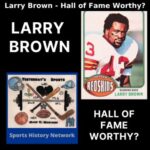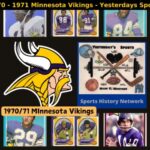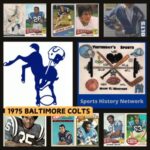Before we get to the 1980 season, let’s take a look at some team history. From 1933 to 1942 the Eagles lost a lot. After ten losing seasons in a row, they went 5–4–1 in 1943. But with half the players serving in World War ll, the Eagles had to combine their team with the Pittsburgh Steelers, calling themselves the “Steagles”. The Steagles returned to being the Eagles in 1944 and had their best season, finishing with a 7–1–2 record, but they lost the Division Title to the NY Giants who went 8–1–1.
After finishing 7–3 in 1945 and 6–5 in 1946, they went 9–4 in 1947 before losing to the Chicago Cardinals in the NFL Championship Game.
The Eagles hit their peak in 1948 & 1949, winning 22 games while losing only three. The 22 wins included two NFL Championship titles.
The best the team could do for the next ten years was a 7–4–1 record in 1954 and 1955. But the Eagles finished the 1960 season with a 10–2 record before defeating the Green Bay Packers for their third NFL Title.
The Eagles had a 10–4 record in 1961 but finished a half-game behind the division-leading Giants.
For the next sixteen years, the Eagles had only one winning season. Their losing ways ended with the hiring of Dick Vermeil as head coach in 1976. The team made the playoffs as a wild card in 1978 but lost in the first round. In 1979 they again reached the playoffs as a wild card but lost in the second round. But it was obvious to all that this team had the talent and hunger to be a serious contender for the Vince Lombardi Trophy.
LISTEN ON YOUR APP OF CHOICE
1980 Philadelphia Eagles
The Eagles opened the 1980 season with an impressive 27–6 victory over the Denver Broncos. The defense held Denver to only 233 yards while the Eagles’ offense gained 421 yards. Quarterback Ron Jaworski had an outstanding game completing 18 of 28 passes for 281 yards and three touchdowns. Receiver Harold Carmichael caught three passes for 135 yards, including a 56-yard touchdown.
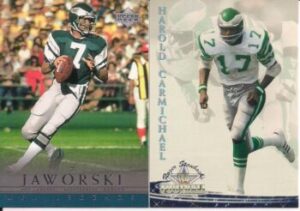
The Eagles looked just as impressive in week two outgaining the Vikings 529 yards to 207 en route to a 42–7 win. Ron Jaworski had another great game completing 20 of 26 passes for 232 yards and two touchdowns.
Wilbert Montgomery ran for 169 yards on 20 carries, including a 72-yard touchdown run. Harold Carmichael had another big game catching five passes for 95 yards with one touchdown, while backup receiver Scott Fitzkee caught a 45-yard touchdown pass.
The Eagles kept soaring with a 35–3 win over the Giants in week three. Wilbert Montgomery ran for 87 yards on 15 carries and added another 67 yards on six receptions. Ron Jaworski completed 18 of 29 passes for 240 yards and three touchdowns.
A Strong Start
After three games the Eagles had outscored their opponents 104–16. It seemed too good to be true, and it was. They lost in week four to a bad St. Louis Cardinals team. Harold Carmichael had another good game catching five passes for 108 yards but Ron Jaworski did not. He completed only 16 of 36 passes and threw three interceptions. Defensively the Eagles had a tough time stopping running back Otis Anderson who gained 151 yards on 27 carries and scored two touchdowns.
The Eagles didn’t dwell on the unexpected loss for long. After falling behind the Redskins 7–0, Jaworski connected with running back Leroy Harris on a 51-yard touchdown reception. The Eagles never looked back and went on to a relatively easy 24–14 win.
In a week six game against the Giants, it looked like another upset was in the making. The Eagles were behind 16–3 at halftime. But they scored four touchdowns in the second half for a 31–16 victory. The Eagles defense gave up only 161 yards while the offense cranked out 329 yards. Jaworski had another solid game completing eighteen passes for 212 yards with one touchdown and no interceptions.
The Eagles’ seventh opponent was the Dallas Cowboys. The two teams were tied for first place in the Eastern Division with a 5–1 record. Neither team could establish much of a running game, but the Eagle’s defense also shut down the Cowboys’ passing game. Although Danny White passed for 222 yards, it took him 38 attempts, and he threw three interceptions. Jaworski threw 25 times and completed 13 for 214yards with two touchdowns and one interception. The final score was Philadelphia 17, Dallas 10.
With the division lead in hand, the Eagles had to be careful not to let down their guard against a weaker Chicago Bears team. The Eagle’s defense held the Bears to only 113 yards through the air and Walter Payton to 79 yards rushing. With Wilbert Montgomery out of action due to an injury and Joe Pisarcik filling in for an injured Ron Jaworski, the Eagles played a lackluster game on offense and eeked out a 17–14 win.
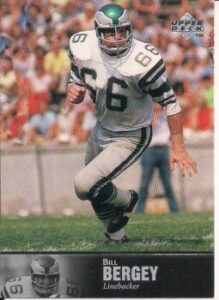

In a week 9 game against the Seattle Seahawks the game plan for both teams was to throw the ball. Seattle quarterback Jim Zorn threw 35 times for 250 yards. Jaworski threw 30 times for 253 yards. Receiver Charlie Smith had a big game with 5 receptions for 109 yards and one touchdown. The Eagles won 27-20.
For the second week in a row, the passing game reigned supreme. The Saints threw the ball 48 times for 370 yards but were held to three touchdowns. With running back Wilbert Montgomery still out of the lineup with an injury, Jaworski threw the ball 32 times for 323 yards and three touchdowns. Charlie Smith had another great game catching 9 passes for 137 yards. The Eagles cruised to a 34–21 win.
The Eagles played a fairly conservative game on offense in a week 11 game against the Redskins, but their defense played perhaps their best game of the season. They held Washington to 13 first downs and only 218 yards. They also forced five turnovers, including a fumble which linebacker Jerry Robinson returned 59 yards for a touchdown. The final score was Philadelphia 24 Washington 0.
Keeping the Winning Going
The winning continued the following week against the 8–3 Oakland Raiders in an old-fashioned defensive battle. The Eagles held a 3–0 lead after three quarters, but the Raiders struck lightning in the fourth quarter when Jim Plunkett connected with Cliff Branch for an 86-yard touchdown.
But later in the quarter, Wilbert Montgomery scored on a three-yard touchdown to give the Eagles a 10–7 victory. The Eagles offense managed only 181 total yards but their defense allowed only 237 yards, forced three turnovers and sacked Jim Plunkett eight times.
With the win against Oakland, the Eagles improved their record to 11–1, but the Cowboys were right on their heels at 10–3. The two teams would meet in the final game of the season. A loss to the Chargers in week 13 would make things much tighter. San Diego led 19–0 at halftime but the Eagles came storming back in the second half scoring three touchdowns. But it wasn’t enough, as the Chargers added a field goal to win 22–21.
Jaworski played a good game completing 20 of 31 passes for 201 yards with two touchdowns. Wilbert Montgomery, fully recovered from his injury, gained 61 yards rushing and 78 yards receiving and scored two touchdowns. But the Eagles defense couldn’t stop the Chargers potent passing attack. Quarterback Dan Fouts passed for 342 yards and receiver John Jefferson caught eight passes for 164 yards.
The Eagles would now play the 10–3 Atlanta Falcons. With only a one-game lead on the Cowboys, this was an important game. With the score tied 17–17 in the fourth quarter, the Falcons kicked the game-winning field goal. The Eagles couldn’t establish a running game and Ron Jaworski didn’t have one of his better days, completing only 16 of 35 passes for 207 yards while throwing two interceptions.
The Eagles’ defense had a tough time stopping the running combo of William Andrews and Lynn Cain who combined for 173 yards on 27 carries. The Cowboys defeated the Raiders 19–13.
Two weeks earlier Eagles fans had high hopes of winning their first championship since 1960. Now they weren’t feeling nearly as confident. The week 15 game against the Cardinals was a must-win game. Offensively Charlie Smith had a big game catching 7 passes for 134 yards.
Defensively the defense completely shut down the Cardinals. Otis Anderson, who had run all over the Eagles earlier in the season, was held to 39 yards on 17 carries. The Cardinals had only 8 first downs and 126 total yards.
One day after the Eagles defeated the Cardinals the Cowboys lost to the Rams on Monday Night Football. The final game of the regular season was played on December 21 on a cold day at Texas Stadium. To win the division title, the Cowboys needed to beat the Eagles by at least 25 points, and they were doing just that, leading 35–10 in the fourth quarter.
But the Eagles scored 17 unanswered points and won the division while losing the game 35–27. Other than a 25-yard run by Wilbert Mongomery the Cowboys shut down the Eagle’s running game, but they couldn’t stop their passing attack. Jaworski completed 18 of 30 passes for 331 yards and one touchdown.
But there was cause for concern defensively as Cowboys quarterback Danny White connected on 16 of 24 passes and threw four touchdowns. Receiver Tony Hill caught 4 passes for 110 yards.
Ron Jaworski, Harold Carmichael, and nose tackle Charlie Johnson made the Pro Bowl. Johnson also made All-Pro.

1980 NFC Playoffs
The Eagle’s opponent in the playoff game would be the Vikings. Minnesota went into this game with an unimpressive 9–7 record and had been soundly defeated by the Eagles earlier in the season. Still, the Eagle’s confidence was slightly shakey after losing three of their last four games.
The Vikings jumped out to a 14–0 lead before the Eagles knew what hit them. But they scored two touchdowns to tie the score 14–14. The Vikings regained the lead when they tackled Jaworski in the end zone but the Eagles scored 17 unanswered points for a 31–16 win. The Eagles defense played extremely well, allowing only 215 total yards.
The Eagles were one win away from playing in their first Superbowl, but their opponent would be the 14–4 Dallas Cowboys, who had just defeated the Eagles handily two weeks prior. The game was played at Veterans Stadium with a wind chill factor of minus 3 degrees.
The Eagles struck first when Wilbert Montgomery ran for a 42-yard touchdown, but the Cowboys tied the score. The halftime score was 7 to 7. The second half belonged to the Eagles who scored thirteen unanswered points for a 20–7 victory. Wilbert Montgomery carried the ball 26 times for 194 yards. The Eagles’ defense played exceptionally well, allowing the Cowboys only eleven first downs, and 206 total yards while forcing four turnovers.
Super Bowl XV
Now it was on to the Superbowl to face the Raiders, whom they had beaten in week 12. Most people predicted an Eagles victory. Things didn’t start well for Philadelphia. The Raiders took a 7–0 lead before running back Kenny King turned a short pass reception into an 80-yard touchdown. The Eagles could only manage a field goal and trailed 14–3 at halftime. But the Eagles had been through this before during the season and always came back.
Hope faded when Jim Plunkett connected with Cliff Branch for a 29-yard touchdown. The Raiders added a field goal to take a 24–3 lead with only one quarter left. The Eagles scored a touchdown in the fourth quarter but it was too little too late. The final score was Oakland 27, Philadelphia 10. The Eagles were not dominated statistically speaking, gaining 360 yards to the Raiders 377, but they turned the ball over four times compared to zero turnovers for the Raiders.

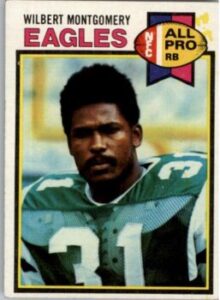
It was a disappointing end to a great season, but Eagles fans could take solace in the team’s winning its first championship in 20 years.
The Eagles would not see the Superbowl again until 2004, losing to the Patriots 24–21. In 2017 the Eagles finally won the Vince Lombardi Trophy, defeating the Patriots 41–33.
Mark Morthier is the host of Yesterday’s Sports, a podcast dedicated to reliving memorable sports moments from his childhood days and beyond. He grew up in New Jersey just across from New York City, so many of his episodes revolve around the great sport’s teams of the 70s for the New York area.
He is also an author of No Nonsense, Old School Weight Training (Second Edition): A Guide for People with Limited Time and Running Wild: (Growing Up in the 1970s)

BOOKS BY MARK MORTHIER
Please Note – As an Amazon Associate I earn from qualifying purchases
More From Yesterday's Sports
Muhammad Ali’s Chin: Knocked Down Only 4 Times
Muhammad Ali’s boxing career is well documented, so instead of...
Read MoreLarry Brown – Is He Hall of Fame Worthy?
A committee member recently asked me my opinion on inducting...
Read More1970s Minnesota Vikings : Would A Better QB Helped Them Win A Super Bowl?
Here’s a question I often hear, especially from Minnesota Vikings...
Read More1975 Baltimore Colts: A Year In Review
From 1957 to 1971, the Baltimore Colts never experienced a...
Read More
